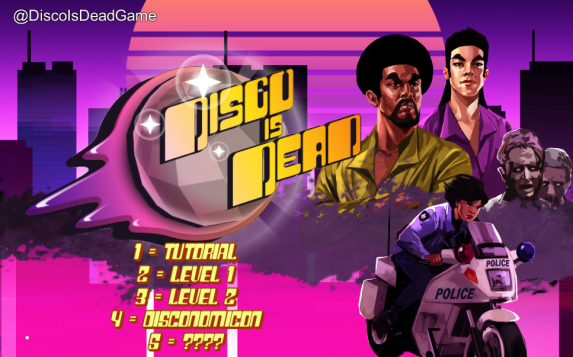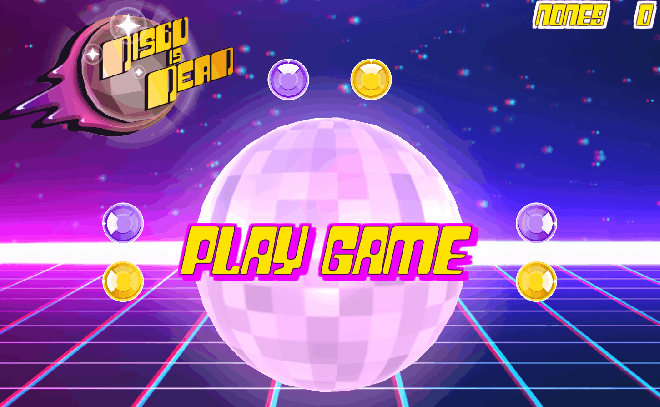With Disco is Dead’s development moving towards the polishing and refinement stage, an area of focus for our team has become the unification of our experience and its completeness. As per recommendations and feedback from trusted individuals, this means construction of a meta-game and framing system around the levels and core game experience, in order to make the game and experience complete.
The style our game is evoking is that of old school arcade games, as well as physical games such as Wii fit, etc.
With the end of the year approaching, we are moving through the implementation pf framing Features traditionally associated with such titles that should be incorporated into our game to make it more complete. The following are the features I will be working on in this update, along with the design goals each will help the game to achieve:
Main Menu
The game has had main menus in the past, but all are relatively simple, and none could really be manipulated using of slapping controller. to resolve both these issues, I will be developing a menu that both makes use of the controllers, and provides the players with indication of how they work. The symbols used to indicate the direction the players should slap in the menu will be the same as those used in gameplay; by using them in the menu, and highlighting their connection to physical directions on the controller, we will be able to prime players for gameplay inputs through the learning space of the main menu.
Design Goals:
- Create a menu whose appearance is appealing and blends in with the rest of the game.
- Have the menu teach the player crucial inputs for playing the game.

Above: The former Main menu, now being applied as our title screen, exhibits no interface which is conducive to the control scheme we use.
Credits Screen: Not an absolute necessity, but something that will help tie the game together and help make it more complete. Unity in design will be shown through allowing the players to slap at the credits as they scroll, turning it into a mini-game akin to those found in games like Rayman Origins and New Super Mario Bros.
Design Goals
- Create a proper, professional conclusion for the game.
- Create a final, fun little component to tie into our theme.
Cutscene/Level Select: In order to allow both ourselves and our users to move easily navigate through the game for players, its important to have this feature implemented into the menu.
Design Goals
- Create an option that allows both players and designers to easily select the level they wish to play.
- Have it integrated in a more appealing way that simply a debug menu, for the sake of polish.
High-score Table and Tracking: As our game draws its primary design from arcade titles, it is reasonable to assume that a major reward for players, particularly when showing the game in a public place like level up or other showcases. players will want to try to get high scores, and we can compare players score and congratulate our current champions, and encourage people to try to top their scores.
Design Goals
- Create a reward that holds value for players during short term play sessions – at showcases, etc.
- Ensure that it meets all tecnical requirements and operates as intended.
Opening and closing each level: Each level should have a concrete beginning and end. To do this, an animation should be appended to the beginning of each level, showing the characters getting ready to go, and a ranking screen should be added to the end, to show the players how they did.
Design Goals
- Frame each level as a part of a larger experience.
- Provide players with feedback on progress, so they feel like each level is capped off by a meaningful result and assessment of their progress.




Above – examples of the intro to a level and the rankings after a level in the comic book inspired rhythm/story game.
Outcomes of Developing for These Issues
Over the course of reading week, I developed all of these systems in order to make the game a more complete experience for players.
Main Menu:
The main menu’s visual design was already somewhat underway, the main challenge was simply ensuring that it effectively presented the player with the ability to switch between options and helped them to learn the mechanics. the final design was to have a disco ball that could be slapped back and forth, spinning and revealing new options – The icons used in the menu are the same as those found in gameplay, and pulse when the player slaps in a direction, showing what each translates to on the head. This, coupled with some sound effects, visuals, and screenshake effects, helps the menu to be both thematically cohesive with the rest of the game, and help to prepare the player for the rest of the game in terms of icon to controller recognition and understanding.

Credits Screen:
The credits screen was farily easy to create, and fits in very well with the overall aesthetic. Players can slap the credits as they roll up the screen, and their scores are talllied, allowing for a fun microgame. The next step for this will be getting our complete credits for the game written out and lined up, so that player’s have a good number of objects to slap, as welll as testing it with players, to see if they enjoy it. Overall, it certainly will form a nice conclusion for anyone who plays through to the end of our game.

Cutscene/Level Select:
The level select is another area of the main menu. while it is functional mechanically, and follows the same style as th erest of the menu, we still may need/want to replace the basic level art that I have for each level with more finalized, polished peices before the final build. In particular, the tutorial’s art is not yet finished, so that will need to be added. The ability to load custscenes was judged to be a bit redundant, as there are only 5 major blocks of cutscenes, each being tied to a level.

High-score Table and Tracking:
The highscore table is functional, and displays the scores of players, shorting and resorting them, and has a nice visual aestehtic that allows for a name of a chosen number of letters to be put in. This may change later, as we discussed the possibility of having disco names for players to choose from. The system that I implemented just grabs the letters as strings from a list, so these could easily be replaced by words, etc. if we decide this is what we desired.

Opening and closing each level:
This is one area that probably still needs some more work. We will have an entire cutscene systems that leads from and to each level, and is on the verge of being implemented and connected. I was able to develop a system to determine and showcase rankings for players at the end of each level.
Conclusion and Moving Forwards:
Overall, I was able to apply reading week towards some significant development in terms of the game’s framing and overall experience. However, some of these elements still require a bit of additional fine-tuning. Moving forwards, the next area of focus will be on play-testing and seeing the effectiveness of all elements that have been introduced, and making any necessary changes.
Images Courtesy Of:
http://crackedrabbitgaming.com/guides/ds/elite-beat-agents/faq/
Elite Beat Agents review. Dance to save the world in this quirky DS rhythm game